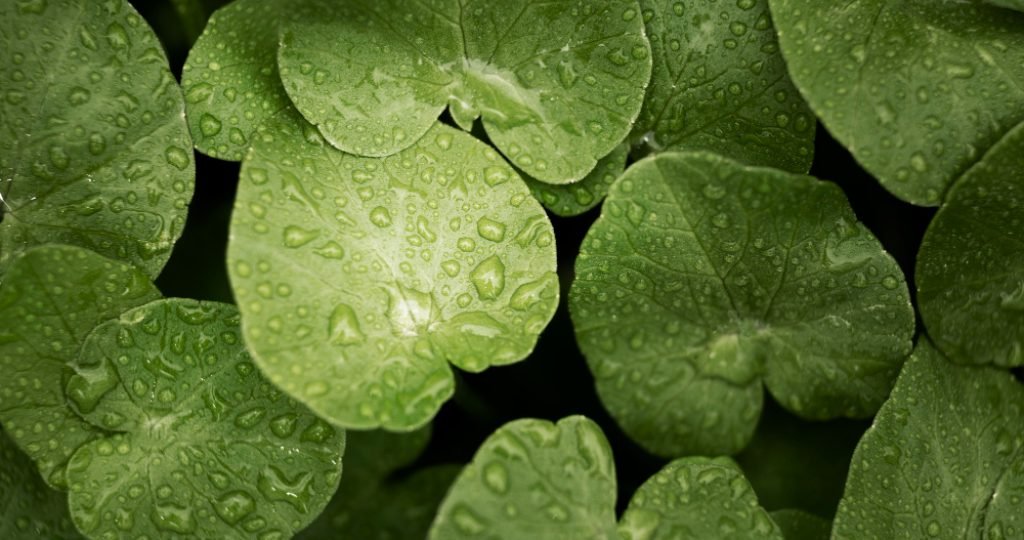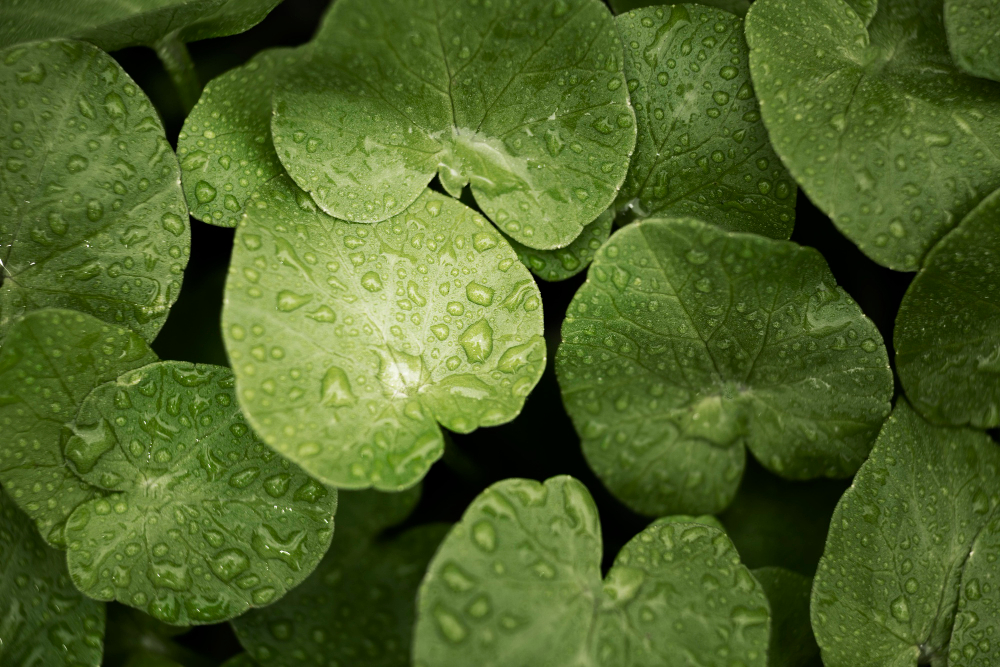Written By: Lavanya Chavhan, B.Pharm
Reviewed By: Ayurvedacharya Dr. Gaurav Pathare, BAMS

Mandukaparni (Gotu Kola) is an ancient Ayurvedic herb known for boosting memory, reducing anxiety, and healing the skin. Backed by clinical evidence and meta-analysis, learn how to use Mandukaparni effectively for optimal health
At Pharmacally, we believe that the best medicine combines ancient wisdom with modern science. One such powerful herb is Mandukaparni a small green leaf with big healing potential.
If you’re dealing with brain fog, skin problems, stress, or slow-healing wounds, Mandukaparni might be the natural support your body needs.
Known scientifically as Centella asiatica (CA), also known as Mandukaparni, Indian pennywort, or Gotu Kola, Mandukaparni has been a part of Ayurvedic medicine for centuries. In ancient texts, it’s described as a “Medhya Rasayana” an herb that nourishes and sharpens the mind. In Sanskrit Manduk means frog and Parni means leaves; which means shape of the leaves are resembled with the shape of feets of the frog, hence Mandukaparni.
Traditionally used in India and Southeast Asia, this herb is now being explored in modern clinical trials and meta-analyses, confirming many of its traditional uses. From boosting brain function to improving skin repair, Mandukaparni is gaining recognition as a truly holistic healer. It is mentioned in ancient texts like the Sushruta Samhita. The herb is also traditionally used in Java, Indonesia, and China, where it is considered a “miracle elixir of life.”
Active constituents involved in pharmacological action of a Mandukaparni
At the heart of its therapeutic power lies a complex array of phytochemicals, natural compounds that work in synergy to promote healing.
At the core of Mandukaparni’s healing power lies a unique group of compounds known as triterpenoid saponins. The most studied are asiaticoside and madecassoside. These compounds are primarily responsible for promoting wound healing by stimulating collagen synthesis and reducing inflammation.
In addition to triterpenoids, Mandukaparni contains significant amounts of flavonoids and polyphenols such as quercetin, kaempferol, and rutin. These compounds contribute to the herb’s potent antioxidant activity, helping to neutralize free radicals and protect brain cells from oxidative stress. Studies suggest that these flavonoids work in synergy with triterpenoids to enhance cognitive functions and delay age-related neurological decline.
Mandukaparni also yields a variety of essential oils, obtained through steam distillation of its leaves. Key volatile compounds include caryophyllene, pinene, and humulene, each of which exhibits antimicrobial, anti-inflammatory, and mood-stabilizing properties. These oils are often used in skin creams, ointments, and aromatherapy preparations for added therapeutic benefit, particularly in wound care. Further phytochemical screening reveals the presence of β-sitosterol, a plant sterol known for supporting cardiovascular health and cholesterol balance.
Health Benefits of Mandukaparni
Sharpens Memory & Boosts Mental Clarity
Mandukaparni is widely recognized as a natural brain tonic. It is believed to nourish the nervous system, support cognitive functions, and promote mental clarity. Regular use is said to enhance memory retention, sharpen focus, and reduce mental fatigue, making it a popular choice among students and individuals under high mental stress.
Reduces Stress & Calms the Mind
This herb is often used to soothe anxiety, restlessness, and irritability. In Ayurvedic texts, Mandukaparni is said to balance the “vata” dosha, which governs the nervous system. It promotes a calm, grounded mental state and helps reduce symptoms of stress-induced imbalances such as insomnia, overthinking, and emotional instability.
Revitalizes Skin Health
Mandukaparni has long been used to improve skin texture, tone, and elasticity. It is considered excellent for managing various skin disorders including dryness, discoloration, and minor wounds. Its regenerative properties support faster healing of cuts, scars, and burns while rejuvenating the skin from within.
Supports Cardiovascular and Circulatory Health
Centella asiatica is believed to strengthen blood vessels and promote better circulation. It may help relieve symptoms of varicose veins, swelling in the legs, and heaviness caused by poor venous return. By improving blood flow, it nourishes tissues and supports overall vascular health.
Supports Healthy Digestion
Mandukaparni is traditionally used to soothe and strengthen the digestive tract. It may reduce inflammation in the gut lining and improve digestion by calming excess heat and acidity. It’s also believed to promote better assimilation of nutrients and relieve minor digestive discomfort.
Promotes Longevity & Rejuvenation
In Ayurveda, Mandukaparni is regarded as a rasayana a substance that promotes longevity, vitality, and youthfulness. It is believed to rejuvenate tissues, slow down the aging process, and maintain balance in the body’s natural systems. Regular use is said to support energy levels, immunity, and overall well-being.
Improves Hair and Scalp Health
Applied externally or taken internally, Mandukaparni is beneficial for hair strength and scalp nourishment. It is traditionally used to reduce hair fall, promote hair growth, and combat dandruff. Its cooling nature helps soothe inflamed or itchy scalps, promoting a healthy hair environment.
Supports Joint Flexibility & Tissue Repair
The herb is believed to support flexibility and joint mobility. It helps nourish connective tissues, strengthen cartilage, and reduce stiffness, making it useful for people experiencing age-related wear and tear or joint discomfort.
How to Take Mandukaparni for Best Results
Form | Dosage | Usage |
Capsules/Tablets | 300–600 mg per day | With water after meals |
Powder (Churna) | 1–2 grams daily | Mix with warm water, honey, or ghee |
Decoction (Kashayam) | 30–50 ml | Once or twice daily |
Tea | 1–2 cups/day | Boil leaves for 10 minutes |
Topical Creams | As directed | For wounds, scars, and skin rejuvenation |
Note: Always consult your healthcare practitioner or Ayurvedic expert before starting any new herb, especially if you are pregnant, nursing, or taking medications.
Conclusion
Mandukaparni (Centella asiatica) stands as a timeless herbal treasure that gently nurtures the body, mind, and spirit. From sharpening memory to calming the nervous system, revitalizing the skin, supporting circulation, and rejuvenating the joints, its wide-reaching benefits are a testament to its revered status in Ayurveda as a medhya rasayana and rasayana a promoter of both intellect and longevity.
What gives Mandukaparni its unique healing potential is not just its traditional value, but also its rich phytochemical profile. It contains powerful bioactive compounds such as asiaticoside, madecassoside, asiatic acid, and madecassic acid. These triterpenoids are known to support tissue regeneration, enhance collagen synthesis, reduce inflammation, and promote neuroprotection at a cellular level. Additionally, the presence of flavonoids and saponins further enhances its antioxidant and adaptogenic properties.
In essence, Mandukaparni is more than a medicinal herb it is a holistic ally for modern wellness. Whether you’re seeking clarity of mind, youthful skin, restful sleep, or internal balance, this humble green leaf has something to offer.
References
Boju Sun, Lily Wu, You Wu et al, Therapeutic Potential of Centella asiatica and Its Triterpenes: A Review, Front. Pharmacol, 04 September 2020 Sec. Ethnopharmacology Volume 11 – 2020 | https://doi.org/10.3389/fphar.2020.568032
Oluranti Mopelola Lawal, Fatima Wakel, Matthijs Dekker, Consumption of fresh Centella asiatica improves short term alertness and contentedness in healthy females, Journal of Functional Foods, Volume 77, 2021, 104337, https://doi.org/10.1016/j.jff.2020.104337.
Lokanathan Y, Omar N, Ahmad Puzi NN, Saim A, Hj Idrus R. Recent Updates in Neuroprotective and Neuroregenerative Potential of Centella asiatica. Malays J Med Sci. 2016 Jan;23(1):4-14. PMID: 27540320; PMCID: PMC4975583.
Eduviere, A. T., Awhin, P. E., Edje, K. E., Otomewo, L. O., Adeoluwa, O. A., & Winter, J. E. (2021). Adaptogenic potential of Centella lujica supplement in sleep deprived mice. International Journal of Research in Medical Sciences, 9(11), 3269–3276. https://doi.org/10.18203/2320-6012.ijrms20214408
Jeevan Chandra, Himanshu Joshi, Pankaj Bahuguna, Anti-stress effect of Centella asiatica in rats, Sch. Acad. J. Biosci., 2015; 3(8):668-675, DOI : 10.36347/sajb.2015.v03i08.005
Gohil KJ, Patel JA, Gajjar AK. Pharmacological Review on Centella asiatica: A Potential Herbal Cure-all. Indian J Pharm Sci. 2010 Sep;72(5):546-56. doi: 10.4103/0250-474X.78519. PMID: 21694984; PMCID: PMC3116297.
Health Benefits of Mandukaparni (Centella Asiatica), https://www.all-cures.com/cure/5451-Health-Benefits-of-Mandukaparni-(Centella-Asiatica)
Tan, S.C.; Bhattamisra, S.K.; Chellappan, D.K.; Candasamy, M. Actions and Therapeutic Potential of Madecassoside and Other Major Constituents of Centella asiatica: A Review. Appl. Sci. 2021, 11, 8475. https://doi.org/10.3390/app11188475
Razali NNM, Ng CT, Fong LY. Cardiovascular Protective Effects of Centella asiatica and Its Triterpenes: A Review. Planta Med. 2019 Nov;85(16):1203-1215. doi: 10.1055/a-1008-6138. Epub 2019 Sep 20. PMID: 31539918.
Dora Bhavna, Khatri Jyoti, Centella Asiatica: the elixir of life, International Journal of Research in Ayurveda & Pharmacy, 2(2), 2011 431-438

